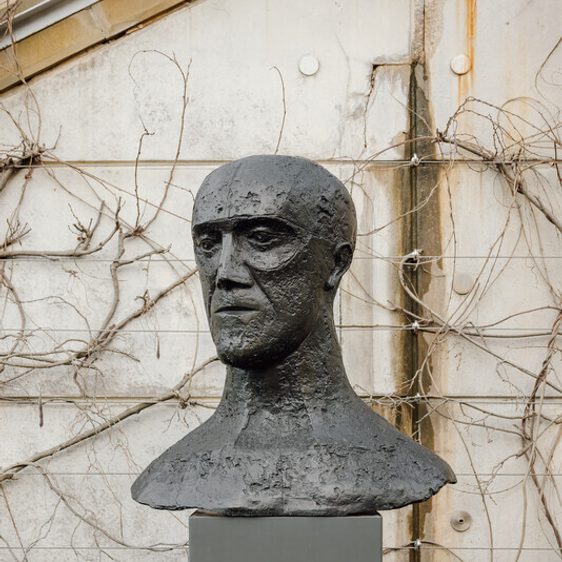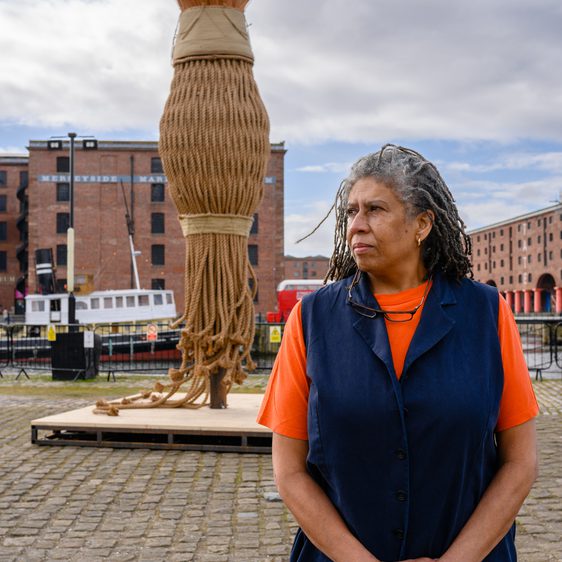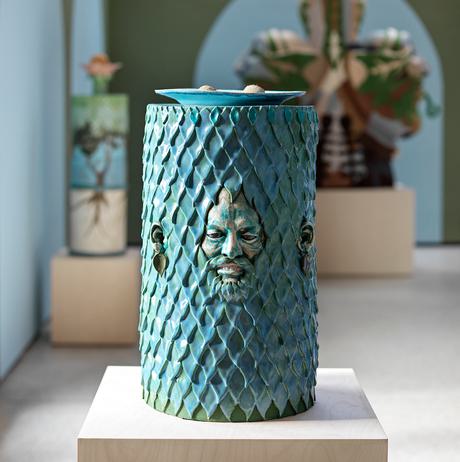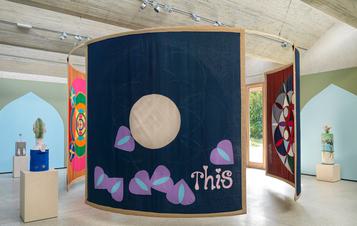
About Jonathan Baldock: Touch Wood
Touch Wood by Jonathan Baldock was a sensory feast of colour, texture, sound and scent. It featured new works in ceramic, textile and basketry that were all created by the artist especially for YSP.
Together they took inspiration from the seasons, paganism, myth, folklore, and our deep connection
to nature. The exhibition also featured imagery drawn from the medieval art and architecture of nearby Wakefield
Cathedral. Baldock makes his work using materials and techniques that have passed down through
generations. These traditions are rooted in the histories of working-class people.
Four textile panels that represent spring, summer, autumn and winter hung in the centre of the gallery. They reflect the different spirit and colours associated with each season. Designs inspired by sacred geometry are sewn onto their surfaces. These shapes refer to recurring growth patterns found throughout the natural world, and similar emblems are also common in medieval church graffiti. Although the purpose of these symbols is unknown, they could be connected to ritual protection from evil spirits.
Humour and storytelling are important elements in Baldock’s artwork. Shapeshifting and hybrid characters allow him to explore a fluid, queer space without rules or binaries. For Touch Wood he has made new textile sculptures based on three 500-year-old wooden carvings in Wakefield Cathedral. The first is of a person exposing their buttocks. Although this seems an unlikely subject to be found in a church, bawdy images like this were common in medieval times. The others are composite creatures: a sphinx-like beast with an animal’s body and a human face; and a Green Man. This is an ancient, mythical figure associated with spring, transformation and rebirth, with a face made of leaves. Baldock’s imagination was sparked by the subject matter, freedom of expression and playfulness of the original carvings.

I’m excited to see how Jonathan is so deftly weaving together influences from many different times and spheres, and interpreting them through a contemporary, queer lens. The connection to the carvings in Wakefield Cathedral celebrates the history of sculpture and makers locally, whilst his interest in the natural world and the rhythm of the seasons resonates with the landscape at YSP. Jonathan is a dynamic, thoughtful and playful artist whose installations bring joy as well as challenge.
- Sarah Coulson, Senior Curator at YSP
Baldock’s affinity to nature is deep-rooted. He comes from generations of hop-gatherers and gardeners whose relationship with the land was physical, emotional and sustaining. Some ceramic works shown here merge plant and human life. Becoming Plant (a Hop) features the artist’s face on one side of a hop flower head and his mum’s face on the reverse. The sculpture celebrates Baldock’s mum as a central presence in his life and the person who taught him how to work with textiles. It is also a nod to the Green Man.
The soundscape in the gallery was created by musician Luke Barton. Plant Song draws together the themes of the exhibition and moves through a cycle of the seasons, capturing the feeling and rhythm of the year as it passes. Many of the sounds within it were recorded at YSP or in Wakefield Cathedral.

Discover more from Jonathan Baldock
TALK, LISTEN AND QUESTION TOGETHER
Jonathan is an artist who makes joyful art in different materials. He awakens our senses with colour, pattern, sound and texture. Sprinkling humour throughout, he explores myths and legends. Touch Wood is a journey celebrating nature, craft
and storytelling. The gallery could almost be a stage set where something is about to happen.
Spend time together noticing the sounds and smells, patterns and textures.
How does the exhibition make you feel?
What is the first thing you notice? Why?
What are you most curious about? Why?
There are many different types of materials using lots of traditional making skills. See how many ways of making you can spot.
- Think about how people share skills like sewing and gardening and pass these down to others.
- Talk about why it is important to learn different skills.
- What have you learnt from someone else?
Jonathan spent time in Wakefield Cathedral and discovered a carved wooden figure, hidden under a seat. He’s made it into an
enormous artwork and given it a new identity. This figure is no longer hidden or small. Seek out this artwork. It’s called Be fruitful and multiply.
- Why do you think it may have been hidden hundreds of years ago?
- Sometimes we hide who we are or how we are feeling to others.
- It’s not always safe for people to be themselves. Think about how we can help people feel safe and comfortable. How might this figure be feeling in this exhibition?


Jonathan has created a cast of characters. Find one that you would like to be friends with. Imagine the story it might tell.
- Think about whether it’s from the past or maybe a guide for the future.
- What would you like to share with the character?
- What makes you you?Is it your experiences, your dreams, or a mixture of both?
- Why do you think we tell stories?
Seek out No one had paid them any particular attention, this is inspired by the Green Man. He appears in different cultures, often to symbolise the cycle of life, death and rebirth. He is thought of as kind and connected to nature and our land. Spend some time looking at this sculpture. Imagine the stories he has heard.
You may also like
- Art Outdoors

Elisabeth Frink: In Memorium II
Frink succeeds in capturing a sense of defiance with In Memoriam II as the features of the figure express great sadness but also a sense of dignity. - News

Yorkshire Sculpture Park announces 2023 programme
16 November 2022 
LR Vandy: Rise
From 14 March 2026Rise is an ambitious first solo museum exhibition by LR Vandy, created for The Weston Gallery- News

The Weston Restaurant named winner of Trip Advisor Travellers' Choice Award
28 September 2023



